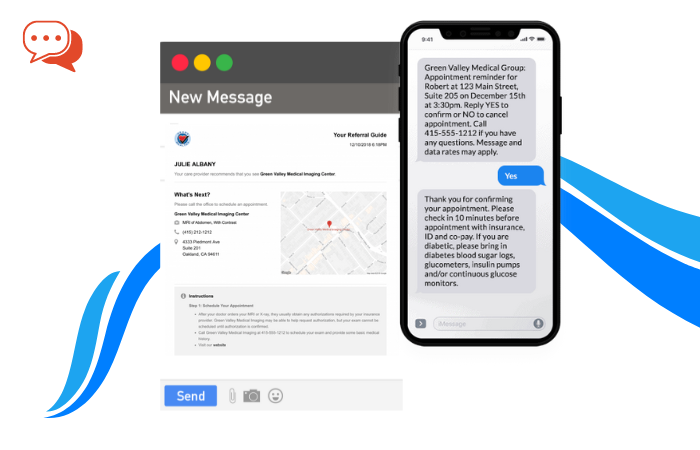As the coronavirus swept the globe, industries of all kinds had to find new ways to keep their consumers happy while healthy and safe. This mission was of increasing importance to the healthcare field, as the primary goal of medical services is to promote and protect the best quality of life possible for patients of all ages and backgrounds. As social distancing and mandatory shelter-in-place orders were issued, it upset the normal routine of life for many people. However, those in the medical field also faced challenges with limited supplies, such as masks and protective equipment. Hospitals and care centers in pandemic hotspots took a lot of the available medical supplies, while other locations began to stockpile in preparation for their own battle against COVID-19. This led many medical facilities offering routine, online services or elective surgeries to put the brakes on patient appointments, only seeing those with a medical emergency.
Healthcare Goes Digital
In the wake of the shutdown and the limitations on the healthcare industry, many practitioners found a way to continue seeing patients through digital means. The use of technology for medical care isn’t something new, but the pandemic showed just how easily it could be incorporated on new levels. Things like medical billing, surgical services, imaging, and record-keeping have seen drastic changes as innovation in tech and software have improved, but there was still a lot of hesitancy for delivering patients consultations and health checkups through virtual meetings online. However, with few other options in the height of COVID-19, many online services and opportunities proved their worth. The key areas in which medical professionals are using online means to interact and service patients are through virtual appointments, billing services, testing and results, and self-service portals.

1. Billing Services With Online Services
Many people don’t get excited about the cost of healthcare services and the bill they receive in the mail, but medical professionals that use online services for billing are doing their patients a favor. When physicians and their offices rely on an electronic document management system, it simplifies the claims filing and billing practices for staff and patients, but it also improves accuracy. With a DMS healthcare strategy, all the paperwork that has been filled out by a patient or professionals is converted into an electronic document. As office staff complete files and prepare claims, missing signatures or documents could keep records from being accurate, complete, and even paid. Loose paperwork can get lost, misplaced, or misfiled, leading to complications with patient care, insurance claims, and safety or privacy concerns. Electronic files are more easily managed and recorded without fear of getting lost. It ensures regulatory compliance for the medical office as well as proving enhanced security features for patient information.
In addition to using a DMS system, digital insurance filing systems make it easier for both the medical staff and patients to know what’s going on with the patient’s bill. When a patient presents their insurance card or submits it electronically, online access allows the front-end to know what the patient’s financial responsibility is or what services will and won’t be covered. This can reduce a lot of confusion and chaos concerning unexpected bills and past due amounts that patients are not able to pay. By taking advantage of online healthcare management systems, it improves how patients respond to their bills and financial responsibilities. It can also reduce the financial burden on the medical professional, helping keep costs down for their patients.
2. Virtual Appointments
The varying health needs of individuals make it a lot harder to gain adequate and accurate medical advice without consultation or examination from a licensed medical physician. Too often individuals will turn to online sources like WebMD or a random blog to find out what their ache or pain might mean. The internet has made it easier to gain access to information, but in the area of medical help, not all of the information should be trusted and supplied. Fortunately, the internet has opened up access to experienced, licensed physicians for people all around the globe. Medical professionals from all disciplines of mental and physical health are able to use virtual appointments to connect with patients. More than just a phone call, live video connections allow a physician to see their patient. Adding this layer of visual assessment makes the service more personal, but also more accurate. Doctors are able to notice changes in a person’s health, whether it is the color of their skin, weight gain or loss, or flexibility and range of motion changes. There are two primary appointment services you can find online. There are many virtual appointment options by primary care physicians (especially in light of COVID-19 conditions), but telehealth through third-party services and physicians are also booming.
With the number of smartphone and tablet users increasing daily, telehealth companies have found a niche in the healthcare industry. Providing online access to physicians 24 hours a day and seven days a week has revolutionized how patient care is delivered. Just about everyone has access to the internet, through their mobile device, laptop, or tablet, making it a market that knows no bounds. In fact, trends show that online medical services are only increasing, and the competition among online providers is fierce. Just as any industry experiences, building a reputation and strong client base among the patient popular takes both time and high-quality services. The online clinic services of the telehealth providers have some limitations, but for many, the ability to sit at home and live-chat for a prescription refill or to have an antibiotic called into the pharmacy for their ear infection is a huge attraction.
Insurance companies have also seen the benefit of partnering with telehealth companies. Many of the companies offer reduced costs for those who carry employer insurance plans, and Medicare Part B even covers certain telehealth services. The partnership between services and coverage is impacted by both state and federal laws, but as the demand continues to increase for virtual appointment options, more progressive coverage plans will be forthcoming. Dealing with the pandemic has shown that telehealth opportunities are a wonderful way to improve access to healthcare for citizens across the nation, but costs are still a concern for many people. Online delivery of services is a way to make care more affordable, especially as more in-network partnerships are created with telehealth companies. There are two standout online physician services that have gained a lot of attention for cost and efficiency.
- SteadyMD: This is a fully online service that has branded itself for offering “a completely new approach to primary care.” The draw for these services is that your connection with the online provider could replace your visits to a traditional general practitioner. This isn’t meant to be used as a supplemental service. There is a flat rate for enrolling in the service, and when compared to the average cost of copayments across the country, these rates are more affordable. After you sign up for the service, you get to meet (virtually) with a doctor and discuss your health concerns, medical history, and your lifestyle. In spite of being an online service, you get to keep the same doctor from visit to visit. In between appointments, you are also able to contact your physician through calls or texts.
- MDLIVE: If you are needing general medical help, urgent care, behavioral health care, or dermatological advice, MDLIVE is considered one of the best in the telehealth arena. Within 15 minutes and from the comfort of your home, potential patients can sign up for enrollment. The website publishes the pricing for each appointment, with urgent care services averaging around $75 for either a video or phone visit. Appointments can be made 24 hours a day and seven days a week, with the average wait time to see a doctor being less than 15 minutes. This telehealth company is known for participating in several different insurance plans and group benefits, which drastically reduces the cost of the service.

3. Testing and Follow-Up With Online Services
Having tests run or scans done is unnerving, and in the pre-tech days, a patient would be waiting several days for the results. When medical professionals order tests, many of them receive the results digitally. In some labs and imaging centers, a physician is sent the results the same day. Using online delivery for testing results and sharing them through online imaging access gives patients a clearer and more efficient delivery of testing results. Online services allow a doctor to mark up the image or make notes for a patient to read, and it makes it more convenient for providers to collaborate with one another even from a distance. The images sent electronically can also be stored in the patient’s file, and yet cloud-based storage makes it accessible from a physician that is working at home, in the hospital, or in the office. Digital imaging can be enlarged for better evaluation, and the ability to share the image between specialists improves the accuracy of the diagnosis.
4. Patient Portals and Self-Service
There is a lot to be said about giving patients the tools they need to help themselves. Establishing a patient portal on the provider’s website does just this. Self-service options for patients can extend from scheduling an appointment to requesting a prescription refill. Many of the portal designs give a provider the ability to load the results from lab work or scans, as well as update a summary of the care or information received on the last appointment. Patients are able to review their health information, download copies of their bill, pay their bill online, or request their records to be transferred to a specialist or another healthcare provider. For parents, patient portals make it easy to download copies of immunization or physical records for school or sports clubs. Going online also provides patients and providers with another level of communication. Email or messaging with the office directly are often features of online service portals, freeing up the phone lines at the office for more critical needs.

5. Affordability
Quality healthcare has long been considered a luxury for many people groups across the nation, and access has been a problem for many as well. Since the passing of the Affordable Care Act, healthcare has become a human right. Online delivery of both care and support services had served to increase affordability and access. Technology has made it easier for medical professionals to streamline their operations, both on the administrative end and the delivery of medical care. When healthcare providers allow the changes in tech to inform the way they operate, it translates into savings for their patients.
One of the primary reasons individuals would avoid seeking healthcare for both routine and troubling conditions was the cost. Even those with insurance couldn’t afford the high deductibles or copayments, on top of the premiums already deducted from their paycheck or bank account. As the ACA has made wellness screenings a mandatory inclusion with the most basic insurance coverage, more people are getting the preventative care that they need. However, as insurance providers continue to raise deductible limits and healthcare prices, many people will still struggle to pay their bills. Providers that have been able to reduce their overhead costs, may be able to pass those savings to individuals on a private-pay plan. These payment options may encourage individuals to seek out treatment, even when they are scared of the costs. The introduction of telehealth options will also reduce the costs of care and increase the likelihood of individuals scheduling the health assessments that they need.
6. Education of Online Services
The use of online delivery platforms for patient/provider relationships have extended past telehealth networks and company websites. Social media platforms have become another way for medical professionals to connect with their patients. For many of these users, the goal is to educate the general public and their patients about changes in the healthcare industry, whether it be new regulations or up and coming medical techniques. By focusing on education, providers can empower individuals to take personal responsibility for their health and wellness. Content that is informative and engaging can help steer people toward a healthier lifestyle and mental health. Using live broadcasts to share new prescriptions or treatment options or to host a question and answer session about a topic are forms of preventative care. The healthier individuals stay, the more they reduce their risk of developing illness, diseases, and cancers. Not filling as many prescriptions or not needing as many appointments or hospital stays translates into further cost-savings for individuals.
The online environment and its technological support have done a lot to change the healthcare industry. Medical professionals are able to engage with their patients and the public in a whole new way, creating positive changes in every area of the patient/provider relationship.










